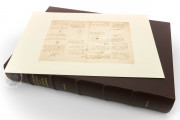The Codex Arundel is a bound collection of notes and drawings by the quintessential Renaissance master, Leonardo da Vinci. Held at the British Library, the codex is a testament to Leonardo's polymathic genius, covering a span of forty years from 1478 to 1518. Comprising 283 paper leaves, mostly sized around 22 cm x 16 cm, the Codex Arundel is the largest collection of Leonardo's papers after the Codex Atlanticus. It showcases treatises on mechanics, the flight of birds, geometry, and more. Unlike the more thematic Codex Leicester, the Codex Arundel seems to be a more random compilation due to the reordering by bookbinders over the years.
The codex, named after Thomas Howard, the second Earl of Arundel who purchased it in the seventeenth century, originally consisted of folios that each served as a mini-treatise on a particular subject. However, later binding practices have dissected this structure, cutting folios into pages and shuffling the content.
Theorizing Gravity before Galileo and Newton?
The Codex Arundel is a treasure trove of Leonardo's thought processes, spanning scientific queries and artistic musings. His mirrored Italian writing offers insights into his innovative mind, detailing inventions and scientific principles that were centuries ahead of their time. Remarkably, the Codex Arundel contains a drawing that suggests Leonardo theorized about gravity, predating Galileo and Newton's work.
The illustration depicts a jug tipping over, releasing its liquid in voluminous spherical droplets that follow a path both outward and downward, tracing the diagonal edge of a neighboring triangle. Divided by perpendicular lines across the triangle, the sketch methodically illustrates gravity's effect, revealing an incremental quickening in the droplets' descent over the passage of time. The doodle, discovered by Dr. Morteza Gharib from the California Institute of Technology in the margins of the Codex Arundel, has been overlooked for ages, as the manuscript has largely been the domain of art historians rather than scientists.
A Mosaic of Invention and Insight
The Codex Arundel encapsulates Leonardo's diverse interests, from hydraulic machines to the study of flight, anatomy, optics, and perspective. It also provides a personal glimpse into his life, with notes on his readings, expenses, and even reflections on the sensation of reality in dreams.
As a scientific manuscript, it originally captivated with its initial pages dense with mechanical studies. Yet, as one proceeds, it reveals a layered complexity, with subjects ranging from astronomy to cosmology and hydraulics. A note from Leonardo himself in 1508 hints at his intention for a more organized compilation—a 'harvest without order' drawn from many papers.
Beyond Science
In terms of its structure, the codex is not just an assortment of scientific musings but also an artistic and literary archive. The oldest known sheet by Leonardo, dating back to around 1478, features texts on a sea monster and a cave. The manuscript unfolds chronologically, featuring works from his early Milanese period, sketches for the Last Supper, and plans for festivals.
The codex's progression chronologically highlights how Leonardo's thoughts on various subjects overlapped and complemented each other, sometimes revisiting themes years later. It paints a portrait of a restless intellect, continually pursuing new inquiries, capturing the essence of the Renaissance spirit of inquiry and innovation.
Finding Its Way to the British Library
The narrative of the codex's journey is as storied as its content. After Leonardo's death, his manuscripts dispersed across Europe. The Codex Arundel found its way into the Earl of Arundel's collection in the 1630s, was later gifted to the Royal Society by his grandson, and eventually purchased by the British Museum in 1831. It became part of the British Library when the two institutions separated in 1973.
We have 1 facsimile edition of the manuscript "Codex Arundel": Il Codice Arundel facsimile edition, published by Giunti Editore, 1998
Request Info / Price











